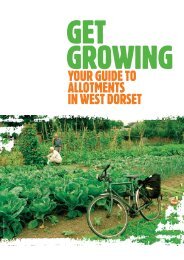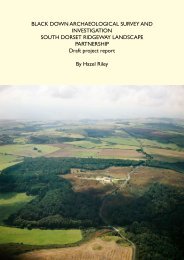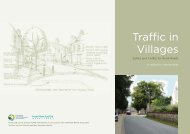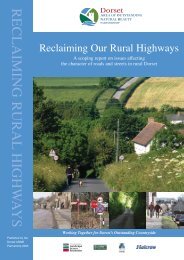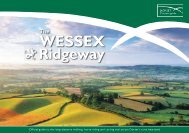Woodland Strategy 11.34 Mb - the Dorset AONB
Woodland Strategy 11.34 Mb - the Dorset AONB
Woodland Strategy 11.34 Mb - the Dorset AONB
Create successful ePaper yourself
Turn your PDF publications into a flip-book with our unique Google optimized e-Paper software.
Section 7<br />
Appendix 2 -<br />
Description of Key Issues<br />
52<br />
Archaeological evidence is a major component of <strong>the</strong> historic landscape. The types of<br />
archaeological remains found within Britain’s woods and forests (often pre-dating <strong>the</strong><br />
woodland) are diverse and include:<br />
• Extant features - Earthworks, cairns, standing stones, buildings and industrial remains<br />
• Subsurface features - Post-holes, buried soils and occupation layers<br />
• Scatters - Including pottery, flint and o<strong>the</strong>r mineral<br />
<strong>Woodland</strong> is significant in this context in that it is unploughed land, and can preserve<br />
archaeological evidence that has often been lost in surrounding agricultural land. However,<br />
that archaeological resource in woodland is often under-recorded, as many such records are<br />
based on aerial survey.<br />
The best management of a site is dependent upon many factors, all of which need to be<br />
considered when developing management plans. The major difficulty is usually identifying<br />
any relevant features and locating <strong>the</strong>m on <strong>the</strong> ground is problematic. Every site or feature<br />
will need some degree of management to minimise <strong>the</strong> risks of any damage. Examples of<br />
some management issues are outlined below.<br />
• Maintaining Tree Cover - The retention of tree cover may also be desirable for its own<br />
historical value. For example where archaeological evidence is directly associated with<br />
past woodland management or sites occur in areas of ancient woodlands. With sensitive<br />
management, tree cover upon or surrounding suitable types of archaeological site could<br />
provide long term, low cost, physical protection. To maintain tree cover whilst minimising<br />
<strong>the</strong> risk of damage to any archaeological evidence, some form of active forest operation<br />
such as thinning or harvesting will be required during <strong>the</strong> tree’s lifetime<br />
• Tree removal - On some sites, <strong>the</strong>re will be a need for tree removal or crown reduction.<br />
The most frequently quoted example of removal is where mature trees are at risk from<br />
windthrow. However, <strong>the</strong> effects of tree removal must also be considered, as it will cause<br />
change in <strong>the</strong> surrounding environment and may have unforeseen impacts upon <strong>the</strong><br />
remaining archaeology.<br />
• Site-specific management - The types of archaeology found within forests or woodlands<br />
are very diverse and of varying degrees of importance. Similarly, <strong>the</strong> site conditions in<br />
which <strong>the</strong>y are found and <strong>the</strong> local flora and fauna also differ greatly. With such<br />
variation, general recommendations on site management are difficult.<br />
• New Planting – Sites containing part or all of an ancient monument, whe<strong>the</strong>r scheduled<br />
or not, should not be planted on, and have a buffer of at least 20 metres. Where<br />
planting occurs within <strong>the</strong> immediate vicinity of an ancient monument <strong>the</strong> choice of tree<br />
species must be carefully considered. The English <strong>Woodland</strong> Grant Scheme and<br />
Environmental Impact Regulations require consultation with archaeologists.<br />
<strong>Woodland</strong> Economics (The role of woodlands and woodland products in <strong>the</strong> current and<br />
future economies)<br />
The rise in awareness and concern of <strong>the</strong> effects of global warming and <strong>the</strong> UK’s<br />
commitment to sustainable energy and a low carbon economy means <strong>the</strong>re are significant<br />
opportunities for <strong>the</strong> revival of woodland management through reducing CO2 emissions<br />
and <strong>the</strong> effects of global warming.<br />
The decline in woodland management can be attributed to reduced economic value of<br />
timber and traditional woodland products. Over <strong>the</strong> last 20 years timber prices have been in<br />
decline and imports have increased, making <strong>the</strong> economic benefits of felling timber less and<br />
less. During 2006 prices have risen due to international trading conditions and those<br />
woodland owners that have continued to manage <strong>the</strong>ir woods and forests are now<br />
seeing benefits of higher returns<br />
In <strong>Dorset</strong>, coppice products such as charcoal, thatching spars and hurdles are increasingly<br />
being imported. Very often <strong>the</strong>se are inferior in both <strong>the</strong> quality of materials and <strong>the</strong><br />
craftsmanship, and in some instances some products are being replaced by plastic. Imports<br />
reduce demand for home produced coppice products and contribute to both <strong>the</strong> dereliction<br />
of coppice woodlands, loss of coppice craftsmen and ultimately impact negatively on <strong>the</strong><br />
condition of woodlands.<br />
Contractors, managers and woodland owners are, and have been under pressure for a<br />
number of years due to low timber prices, and many contractors have gone out of business<br />
and <strong>the</strong> number of woodland/forest managers has reduced. In recent years <strong>the</strong>re has been<br />
a growing alternative outlet for cut timber in <strong>the</strong> form of woodfuel. This is still a relatively<br />
new industry in <strong>the</strong> UK and <strong>Dorset</strong> (in 2006 <strong>the</strong>re were two woodfuel installations in <strong>Dorset</strong>)<br />
and as such <strong>the</strong> market has yet to be proven. This has caused reluctance for those involved<br />
in woodland management to enter this market, especially as currently <strong>the</strong>re is little financial<br />
assistance to aid this diversification.<br />
Deer and Non-native Species<br />
With <strong>the</strong> threats to woodlands from intensive agriculture and development largely in<br />
check, <strong>the</strong> greatest threats to woodland survival apart from climate change are deer and<br />
non-native species. The European <strong>Strategy</strong> on Invasive Alien Species, invasive non-native<br />
species are now considered to be <strong>the</strong> second greatest cause of global biodiversity loss after<br />
direct habitat destruction.<br />
In <strong>Dorset</strong>, deer (predominantly roe and sika with local herds of fallow) and grey squirrels are<br />
by far <strong>the</strong> biggest animal threat and can have an enormous impact on floral and structural<br />
diversity of woodland. Wild boar are increasing in West <strong>Dorset</strong> and are <strong>the</strong>ir impact on



